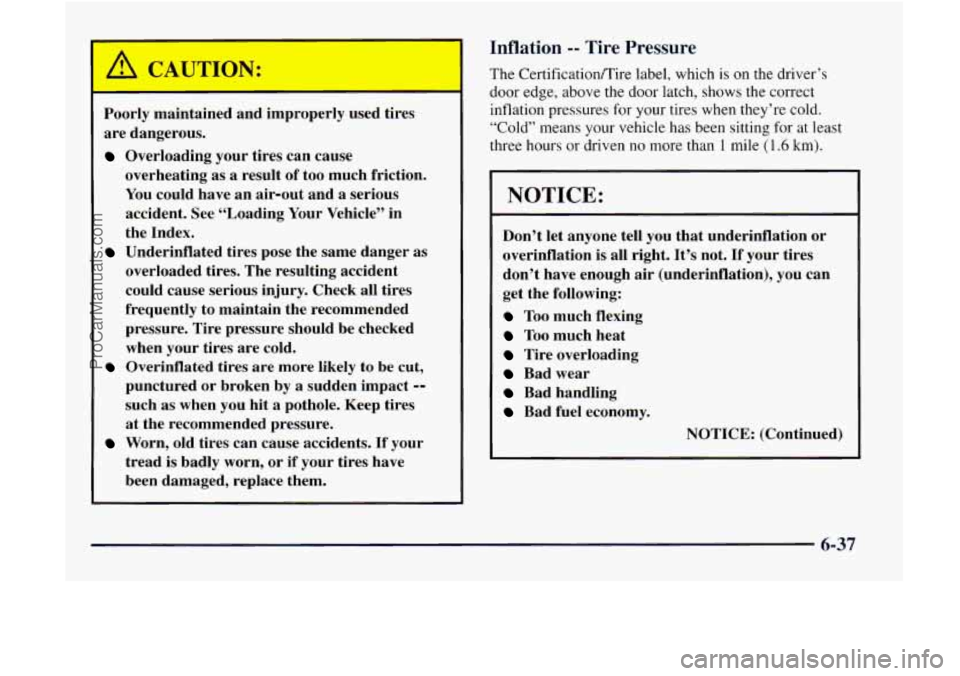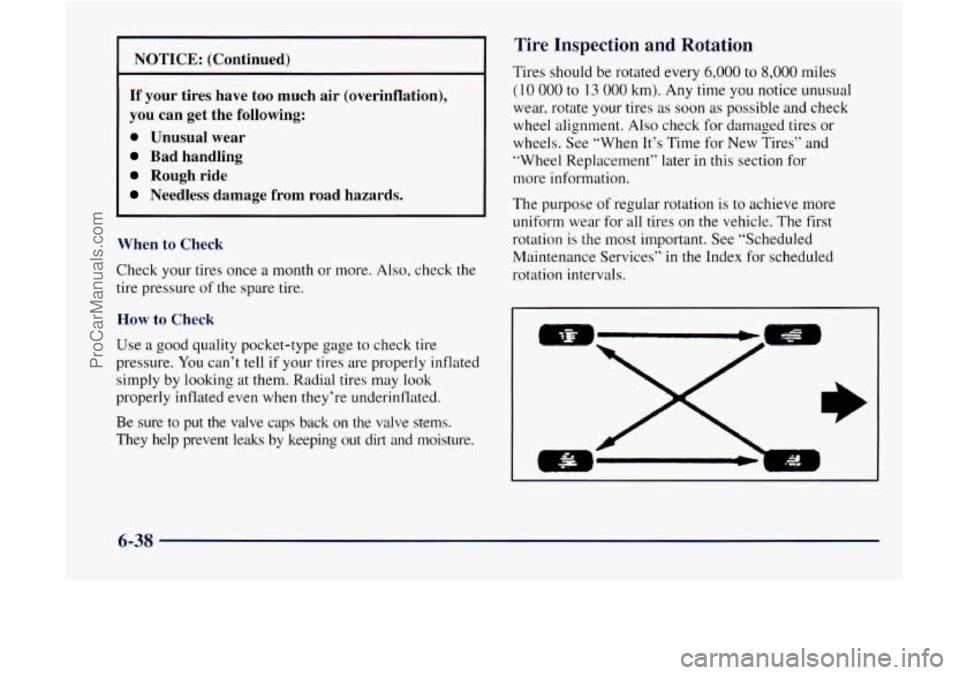1998 GMC ENVOY inflation pressure
[x] Cancel search: inflation pressurePage 199 of 386

Loading Your Vehicle
The CertificatiodTire label is found on the driver’s door
edge, above the door latch. The label shows the size of
your original tires and the inflation pressures needed to
obtain the gross weight capacity
of your vehicle. This is
called the Gross Vehicle Weight Rating (GVWR). The
GVWR includes the weight of
the vehicle, all occupants,
fuel, cargo and trailer tongue weight, if pulling a trailer. The
Certification/Tire label
also tells you the maximum
weights for the front and rear axles, called
Gross Axle
Weight Rating (GAWR).
To find out the actual loads on
your front and rear axles, you need to go to a weigh
station and weigh your vehicle. Your dealer can help
you with this. Be sure to spread out your load equally on
both sides of the centerline.
Never exceed the GVWR for your vehicle,
or the
GAWR for either the
front or rear axle.
If you do have a heavy load, you should spread it out.
Similar appearing vehicles may have different GVWRs
and payloads. Please note your vehicle’s
Certificatian/Tire label or consult your dealer for
additional details.
I
A (- %I---- - -,
Do not load your vehicle any heavier than the
GVWR, or either the maximum front or rear
GAWR. If you do, parts on your vehicle can
break,
or it can change the way your vehicle
handles. These could cause you to lose control. Also, overloading can shorten the life of
your vehicle.
4-40
ProCarManuals.com
Page 284 of 386

Poorly maintained and improperly used tires
are dangerous.
Overloading your tires can cause
overheating as
a result of too much friction.
You could have an air-out and
a serious
accident. See “Loading Your Vehicle” in
the Index.
Underinflated tires pose the same danger as
overloaded tires. The resulting accident
could cause serious injury. Check all tires
frequently to maintain the recommended
pressure. Tire pressure should be checked
when your tires are cold.
Overinflated tires are more likely to be cut,
punctured or broken by a sudden impact
--
such as when you hit a pothole. Keep tires
at the recommended pressure.
Worn, old tires can cause accidents. If your
tread is badly worn, or if your tires have
been damaged, replace them.
Inflation -- Tire Pressure
The CertificatiodTire label, which is on the driver’s
door edge, above the door latch, shows the correct
inflation pressures for your tires when they’re cold.
“Cold” means your vehicle has been sitting for at least
three hours or driven no more than
1 mile (1.6 km).
NOTICE:
Don’t let anyone tell you that underinflation or
overinflation is all right. It’s not.
If your tires
don’t have enough air (underinflation), you can
get the following:
Too much flexing
Too much heat
Tire overloading
Bad wear
Bad handling
Bad fuel economy.
NOTICE: (Continued)
6-37
ProCarManuals.com
Page 285 of 386

NOTICE: (Continued)
If your tires have too much air (overinflation),
you can get the following:
0 Unusual wear
Bad handling
Rough ride
Needless damage from road hazards.
When to Check
Check your tires once a month or more. Also, check the
tire pressure
of the spare tire.
How to Check
Use a good quality pocket-type gage to check tire
pressure. You can’t
tell if your tires are properly inflated
simply by looking at them. Radial tires may look
properly inflated even when they’re underinflated.
Be sure to put the valve caps back on the valve stems.
They help prevent leaks by keeping out dirt and moisture.
Tire Inspection and Rotation
Tires should be rotated every 6,000 to 8,000 miles
( 10 000 to 13 000 km). Any time you notice unusual
wear, rotate your tires
as soon as possible and check
wheel alignment.
Also check for damaged tires or
wheels. See “When It’s Time for New Tires” and
“Wheel Replacement” later in
this section for
more information.
The purpose of regular rotation is to achieve more
uniform wear for all tires on the vehicle. The first
rotation is the most important. See “Scheduled
Maintenance Services”
in the Index for scheduled
rotation intervals.
6-38
ProCarManuals.com
Page 286 of 386

Q
+
I
!
When rotating your tires, always use one of the correct
rotation. patterns shown here.
After the tires
have been rotated, adjust the front and rear
inflation pressures as shown on the Certificationflire
label.
Make certain that all wheel nuts are properly tightened.
See “Wheel Nut Torque”
in the Index.
Rust or dirt on a wheel, or on the parts to which
it is fastened, can make wheel nuts become loose
after
a time. The wheel could come off and cause
an accident. When
you change a wheel, remove
any rust or dirt from places where the wheel
attaches
to the vehicle. In an emergency, you can
use a cloth or
a paper towel to do this; but be
sure to use a scraper or wire brush later,
if you
need to, to get all the rust or dirt off. (See
“Changing a Flat Tire”
in the Index.)
6-39
ProCarManuals.com
Page 350 of 386

Part B: Owner Checks an - Services Engine Coolant Level Check
Listed below are owner checks and services which
should be performed at the intervals specified to help
ensure the safety, dependability and emission control
performance of your vehicle.
Be sure any necessary repairs are completed at once.
Whenever any fluids or lubricants are added to your
vehicle, make sure they are the proper ones,
as shown in
Part D.
At Each Fuel Fill
Engine Oil Level Check
Check the engine oil level and add the proper oil if
necessary. See "Engine Oil" in the Index for
further details. Check
the engine coolant
level and add DEX-COOL'
coolant mixture
if necessary. See "Engine Coolant'' in
the Index for further details.
Windshield Washer Fluid Level Cl: -.
Check the windshield washer fluid level in the
windshield washer tank and add the proper fluid
if
necessary. See "Windshield Washer Fluid" in the Index
for further details.
At Least Once a Month
Tire Inflation Check
Make sure tires are inflated to the correct pressures. See
"Tires"
in the Index for further details.
Cassette Deck Service
Clean cassette deck. Cleaning should be done every
SO hours of tape play. See "Audio Systems" in the
Index for further details.
7-39
ProCarManuals.com
Page 382 of 386

Power ....................................... 1-2
Rear ........................................ 1-6
Reclining Front
............................... 1-4
Seats and Restraint Systems
........................ I - 1
SecondGear ................................... 2-19
Security Warning Light
.......................... 2-70
Service
4WD Light ............................. 2-7 I
Service and Appearance Care ...................... 6- I
Service and Owner Publications .............. 8- 1 1. 8- 12
Service Engine Soon Light ....................... 2-67
Service Parts Identificatmn Label
.................. 6-54
Service Work, Doing Your Own
.................... 6-2
Servicing
Your Air Bag-Equipped Vehicle ........... 1-27
Sheet Metal Darnage
............................ 6-5 1
Shifting ....................................... 2-18
Out of Park
.................................. 2-23
Signaling Turns
................................ 2-3 I
SIR .......................................... 1-20
Skidding
...................................... 4-13
Specifications and Capacities
................. 6-60, 6-6 1
Speedometer ................................... 2-61
Stains, Cleaning ................................ 6-47
Starter Switch Check
............................ 7-4 1
Starting Your Engine ............................ 2- 15
Steam
........................................ 5-12
Steering
In Emergencies ............................... 4- 10
Power ....................................... 4-9
Steering Wheel
. Tilt ............................. 2-30
Storage Compartments ........................... 2-42
Into Piirk .................................... 2-21
Speech Impaired. Customer Assistance ............... 8-4 Storage.
Vehicle
................................ 6-31
Storing
a Flat or Spare Tire and Tools ............... 5-29
Stuck:
In Sand. Mud. Ice or Snow .................. 5-32
Sun Visors .................................... 2-50
Sunglasses Storage
.............................. 2-45
Sunroof
....................................... 2-52
Supplemental Inflatable Restraint
.................. 1-20
Symbols. Vehicle .................................. v
Tachometer .................................. 2-61
Taillamp Bulb Replacement
....................... 6-34
Tape Player Care
.......................... 3-247-39
Theft
......................................... 2-10
Thermostat
.................................... 6-25
Third Gear
.................................... 2-19
Tilt Steering Wheel
............................. 2-30
Time. Setting
................................... 3-8
Tire Chains
.................................... 6-44
Tire Inflation Check
............................. 7-39
Ti res
Alignment and Balance
........................ 6-43
Buyin! New
................................. 6-40
Chang~ng a
Flat .............................. 5-21
Cleaning
.................................... 6-51
Inflation ............................... 6-37. 7-39
Inspection and Rotation
........................ 6-38
Pressure
.................................... 6-37
Temperature
................................. 6-42
Traction
.................................... 6-42
Treadwear
................................... 6-42
THEFTLOCK
TM ................................ 3-21
9-9
.
ProCarManuals.com